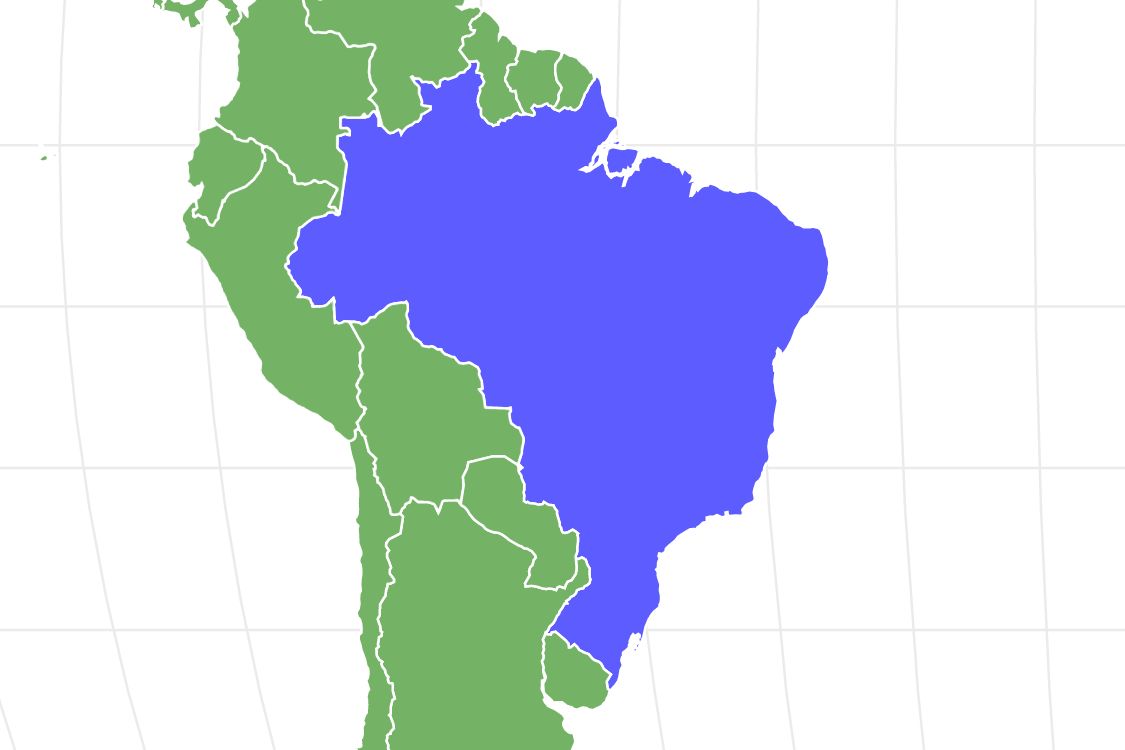Xingu River Ray
Potamotrygon leopoldi
The Xingu River ray is only found in the Xingu River in Brazil.
Advertisement
Xingu River Ray Scientific Classification
- Kingdom
- Animalia
- Phylum
- Chordata
- Class
- Chondrichthyes
- Order
- Myliobatiformes
- Family
- Potamotrygonidae
- Genus
- Potamotrygon
- Scientific Name
- Potamotrygon leopoldi
Read our Complete Guide to Classification of Animals.
Xingu River Ray Conservation Status
Xingu River Ray Facts
- Prey
- Invertebrates and fishes
- Main Prey
- Freshwater snails and crabs
- Group Behavior
- Solitary except during mating season
- Fun Fact
- The Xingu River ray is only found in the Xingu River in Brazil.
- Biggest Threat
- Human activities
- Distinctive Feature
- The Xingu River ray has a venomous stinger on its tail used as a defense mechanism and to capture prey
- Other Name(s)
- White-blotched river stingray, polka-dot stingray
- Gestation Period
- 9–12 weeks
- Litter Size
- 12
- Habitat
- Slow-moving, shallow freshwater like rivers and streams
- Diet
- Carnivore
- Type
- Freshwater stingray
- Common Name
- Xingu River ray
- Location
- Brazil
View all of the Xingu River Ray images!
The Xingu River ray is a freshwater cartilaginous fish in the Potamotrygonidae family. The species is found in the Brazilian Xingu River Basin, a tributary of the Amazon River. It has a dentine spine with venom and is currently threatened in its natural habitat by environmental and human activities. It is also known as the white-blotched river stingray or the polka-dot stingray.
5 Xingu River Ray Facts
- The blotched markings of the Xingu River ray are a perfect camouflage for the ray.
- The white-blotched river stingray reproduces faster than other freshwater stingrays.
- The Xingu River ray prefers clear aquatic environments with rocky bottoms.
- Although they can be kept in aquariums, this stingray tends to have a shorter lifespan when held in a confined aquatic space.
- Xingu River ray has a voracious diet. They can eat as much as three times a day.
Xingu River Ray Classification and Scientific Name
The Xingu River ray is a type of freshwater stingray named after the Xingu River Basin in Brazil. It is also known as the polka-dot stingray or the white-blotched river stingray due to its distinctive black-and-white color. The fish has a blackish body with white dots all over it.
The scientific name of the Xingu River ray is Potamotrygon leopoldi. The fish’s specific name is a nod to Belgian King Leopold III (1901–1983), who funded numerous scientific research projects at the Belgium Museum of Natural Sciences.
Stingrays belong to the Myliobatiformes order, which includes three suborders, four superfamilies, three subfamilies, and ten families. The polka-dot stingray is a freshwater fish belonging to the Potamotrygonidae family. This is a collective family name for the freshwater or river stingrays native to the tropical and subtropical waters of South America. There are five genera of stingrays in this family, including the Potamotrygon genus which the Xingu River ray belongs. There are at least 30 living species in this genus. It shares a close relationship with Potamotrygon henlei from the basin of the Tocantins River and Potamotrygon albimaculata from the Tapajós River Basin.
Xingu River Ray — Appearance
One of the common nicknames of this fish is the white-blotched river stingray or polka-dot stingray. The name is a reference to the striking pattern of white dots on a black or dark brown backdrop which distinguishes the ray. Its underparts are mostly a brownish-dusky color with no polka dots.
Polka-dot stingrays have an oval form typical of most stingrays. Also, they are flat, with an average disc width of about 16 inches. Typically, female species are larger than male species. A mature ray can reach a length of two feet, a width of 11.8 to 30 inches, and weighs up to 44 pounds. The pectoral fins of a large freshwater fish are thick, subcircular, and long rather than broad, giving them the appearance of floating discs.
The fish’s mouth and gills are linked to the belly. When Xingu rays are young, they are more likely to be black, white, or gray. The blotched color only starts to appear as they age.
The polka-dot stingray has excellent vision, just like other freshwater stingrays. Their bulging eyes can see what is above them, even from the river bottom. They also have rows of little thorns and a venomous spine at the tip of the tail. Like the rest of their body, the broad tail is also spotted. Although the ray’s venom doesn’t change as it gets older, the toxicity of the venom does. Approximately every six months, rays periodically shed their stings.
As they age, their jaws get stronger and more rigid, enabling them to eat invertebrates with hard shells. These rays also spend each day burrowing in the river bottom while searching for food at night. Additionally, they possess a unique electroreceptor trait that enables them to detect prey and potential predators through electric fields produced by other living organisms.
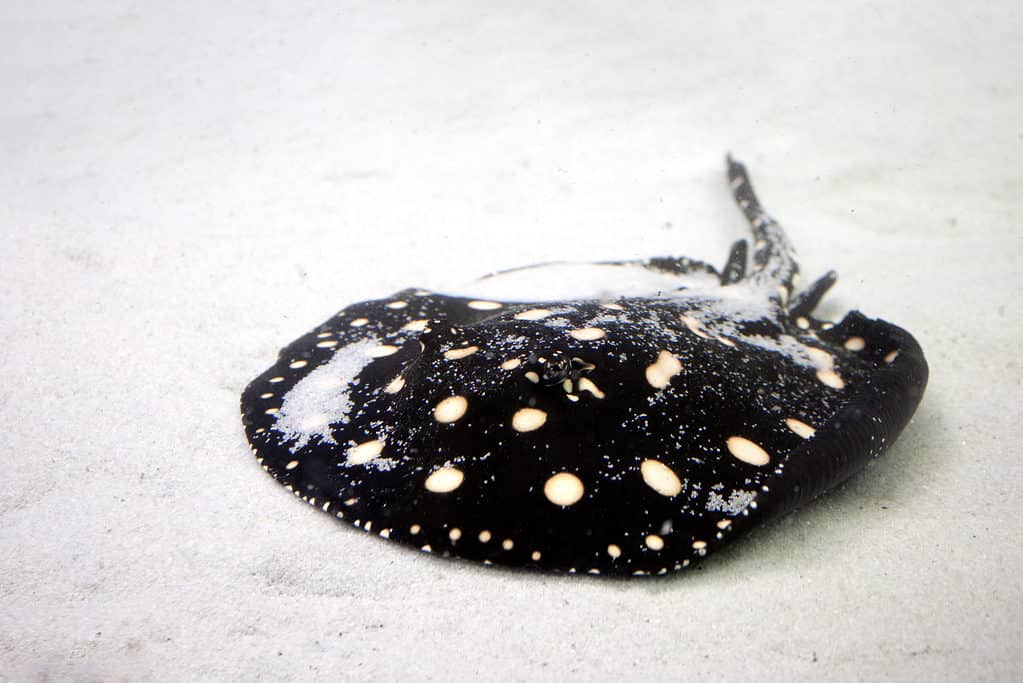
Xingu River ray have a striking pattern of dots on a black or dark brown backdrop which appear as they age.
©iStock.com/Andrii Atanov
Xingu River Ray Distribution, Population, and Habitat
Polka-dot stingrays are endemic to Brazil’s Xingu River Basin, which explains the name of the species. The part of the Xingu River in Pará and Mato Grosso was once believed to be the sole habitat of this endangered species. Later, scientists discovered new populations in the Curuá and Iriri Rivers as well.
The Xingu River, near the City of Altamira in Pará, had a region known as “Cotovelo,” where Potamotrygon leopoldi was very abundant. The rare breed lives in slow-moving waters with mud or sandbanks. However, research shows that it prefers to live in water depths of 13 to 14 feet with stony river bottoms where it can easily eat its prey.
The species is listed as Vulnerable on the IUCN Red List. We know very little about the exact population size of this species. However, they have a limited range, making them quite vulnerable to environmental factors and human activities such as fisheries, sewage disposal, and water contamination from residential and industrial activities.
Under IBAMA (Brazilian Institute of Environment and Renewable Natural Resources) restrictions, the exportation of the Potamotrygon genus from Brazil is currently prohibited. Captive-bred rays are available and are sometimes kept in aquaria. However, the local stingray trade in Brazil is ineffectively regulated, so the illegal trade of the Xingu River ray continues to thrive.
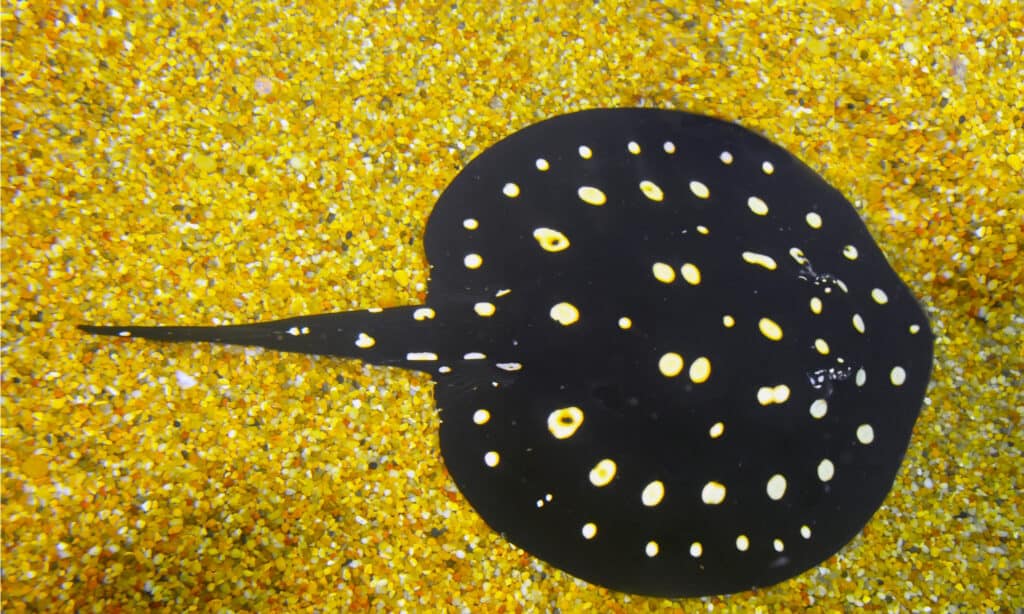
Polka-dot stingrays are endemic to Brazil’s Xingu River Basin, which explains the name of the species.
©Itsik Marom/Shutterstock.com
Xingu River Ray — Evolution and History
The cartilaginous fishes have had one of the slowest evolution rates of all animal species. They split from the bony fish about 381 million years ago. This was during the Early Devonian Period. By the end of the Devonian, they were quite prominent.
The rays and skates diverged from sharks over 200 million years ago. Experts think they may have evolved from the elephant shark or another bottom-feeding shark. The pectoral fins (side fin) of the shark evolved into what is known today as the ray’s disc.
One of the most interesting and unique adaptations shown by the Xingu River ray is that it can feed on prey tougher than its own jaw. Scientists call this feeding technique “durophagy,” and fishes that have evolved to feed on hard-shelled animals like this typically have an edge over competitors for food in the same habitat.
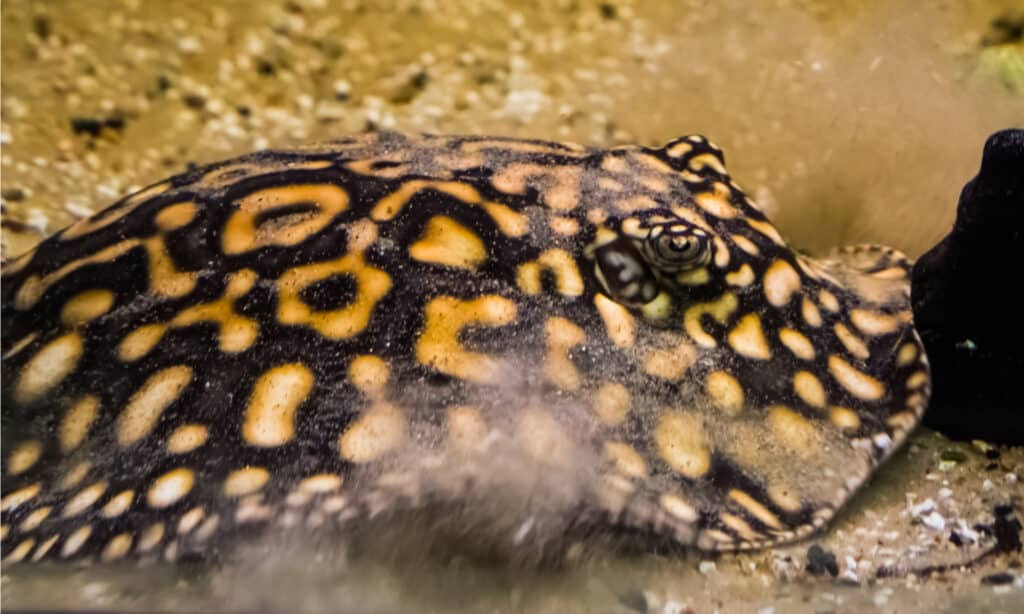
The Xingu River ray can feed on prey tougher than its own jaw giving it an edge over competitors for food.
©Charlotte Bleijenberg/Shutterstock.com
Xingu River Ray — Predators and Prey
This stingray is a carnivorous fish with a diet that includes snails, crabs, and fish. They can dig into button sediments to hide and catch any prey they sense swimming overhead in the water.
What Does Xingu River Ray Eat?
The main components of the white-blotched river stingray’s diet are fish and aquatic invertebrates, but they also eat freshwater snails and crabs. It hunts by hiding in the river bottom and digging a burrow, then attacks when it senses its victim.
What Eats the Xingu River Ray?
The Xingu River ray does not have a lot of predators because of its unique habitat, which keeps it away from sharks, killer whales, elephant seals, and other large aquatic animals that feed on rays. Humans are the most significant threat to this animal species. Although people don’t typically catch them for food, human activities, such as recreation, development projects, damming of the water bodies, and so on, threaten the species.
The flattened body of the stingray is its best defense against predators. It defends itself by hiding in the ocean sand or gravel. It also has a sting on its tail which can deliver painful venom.
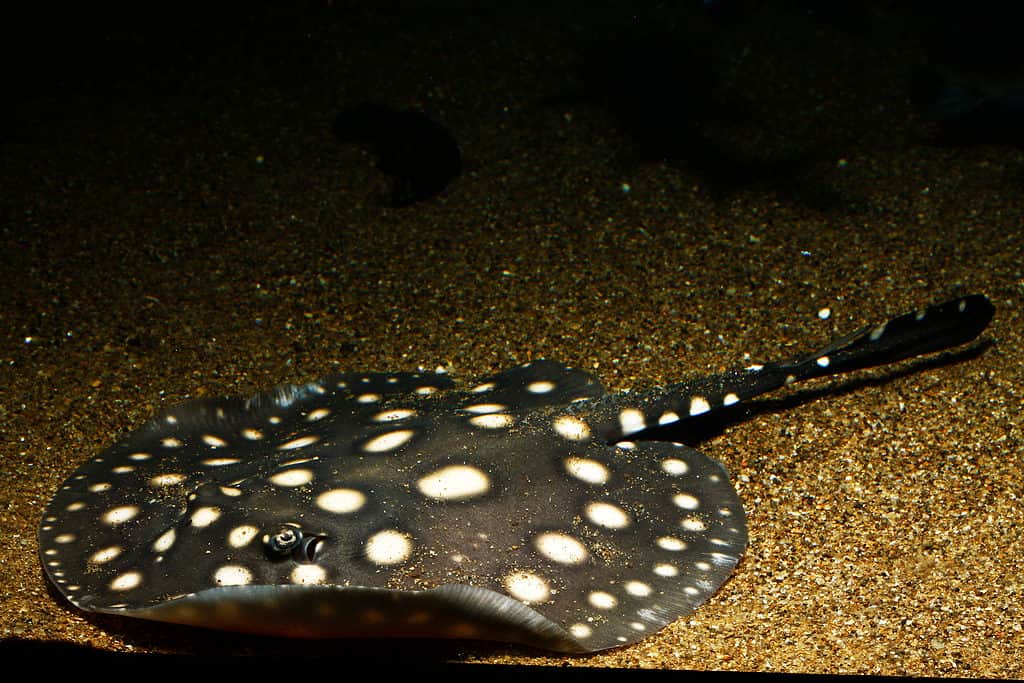
The Xingu River ray will hide in the sand or gravel, but can also protect itself using its venomous tail.
©Pavaphon Supanantananont/Shutterstock.com
Xingu River Ray — Reproduction and Lifespan
The Xingu River ray is an ovoviviparous species. The female produces eggs that hatch inside the body. After hatching, the pup continues to grow in the mother but without a placental attachment and is born alive. They have a yearly reproductive cycle and late sexual maturation, with males reaching first sexual maturity at three to four years old and females at five to six years old.
After copulation during the Xingu River’s floods, the birthing phase begins in the dry season. The size and quantity of the pups produced by the polka-dot ray is one of the unique reproductive traits of this species. Four pups are the usual number of litter for other stingray species. The Xingu River ray litter includes up to 12 individuals. The lifespan is an average of seven to 15 years.
Xingu River Ray In Fishing And Cooking
Due to its scarcity and regulatory limitations, the Xingu ray is rarely seen in restaurants. However, people may sometimes eat this stingray. People grill, smoke or add it as a component of pasta dishes or seafood salad. With 90 calories and 20 grams of protein, stingray meat is a common substitute for scallops.
People seldom fish specifically for this ray. It is often a by-catch in fisheries while fishing for other species. Young species are caught for ornamental purposes and can be kept in aquariums locally. However, there’s a quota system in place to limit export from Brazil to other countries.
Related Animals
View all 13 animals that start with XXingu River Ray FAQs (Frequently Asked Questions)
Where is the Xingu River ray found?
This freshwater species is an endemic fish found in the waters of the Xingu River Basin in Brazil. In the wild, it exclusively lives in the Xingu River. However, it may also be kept as a pet in aquariums under the right conditions.
Does the Xingu River ray bite?
The Xingu freshwater stingray does not bite. However, it has a venomous tail that can deliver a painful sting.
Can the Xingu River ray be eaten?
Though it is rarely seen in restaurants, the polka-dot stingrays are eaten sometimes.
Thank you for reading! Have some feedback for us? Contact the AZ Animals editorial team.
Sources
- Sharks and Rays, Available here: https://www.sharksandrays.com/xingu-freshwater-stingray
- Seriously Fish, Available here: https://www.seriouslyfish.com/species/potamotrygon-leopoldi/
- Florida Sportsman, Available here: https://www.floridasportsman.com/editorial/cooking-stingray-and-skates/399693
- Southeast Asian Fisheries Development Center, Available here: http://www.seafdec.org/documents/2022/08/rtc-cites-2022-ref03-2.pdf
- Zhou Jingqi, Liu Ake,Funan He, Zhang Yunbin, Shen Libing, Yu Jun, Zhang Xiang, 2022/12/01, Draft Genome of White-blotched River Stingray Provides Novel Clues for Niche Adaptation and Skeleton Formation, 10.1016/j.gpb.2022.11.005, Genomics, Proteomics & Bioinformatics, Available here: https://www.researchgate.net/publication/366009458_Draft_Genome_of_White-blotched_River_Stingray_Provides_Novel_Clues_for_Niche_Adaptation_and_Skeleton_Formation

